In this article, I’ll show you how to improve your strategy through benchmark marketing.
Using benchmarks, I’ve been able to identify gaps in hundreds of client’s campaigns and strategies and use those gaps to build marketing plans that hit their growth goals.
Let’s get started.
We’ll Cover:
- Benchmark Marketing Definition
- Different Kinds of Benchmarking
- Importance of Benchmarking
- Industry or Competitor Comparison
- How to Scale Your Digital Marketing Strategy Using Your Benchmark Analysis
- FAQs
What Is Benchmark Marketing?
First, you need to know what a benchmark is.
What is a benchmark in marketing? It’s just a reference point that allows you to make a comparison.
Benchmark marketing is the process of looking at where you’re at versus your competitors. You use the information you gather to fill in and beat any gaps between where you and your competitors stand. Key performance indicators (KPIs) help to identify performance from various angles.
For example, how much does it cost your business to acquire each new customer? And how much does it cost your competitors?
Where are they spending, where are you spending, and what’s the difference in between?
These questions and more help you determine an incremental finish line so you can scale your marketing efforts beyond the status quo.
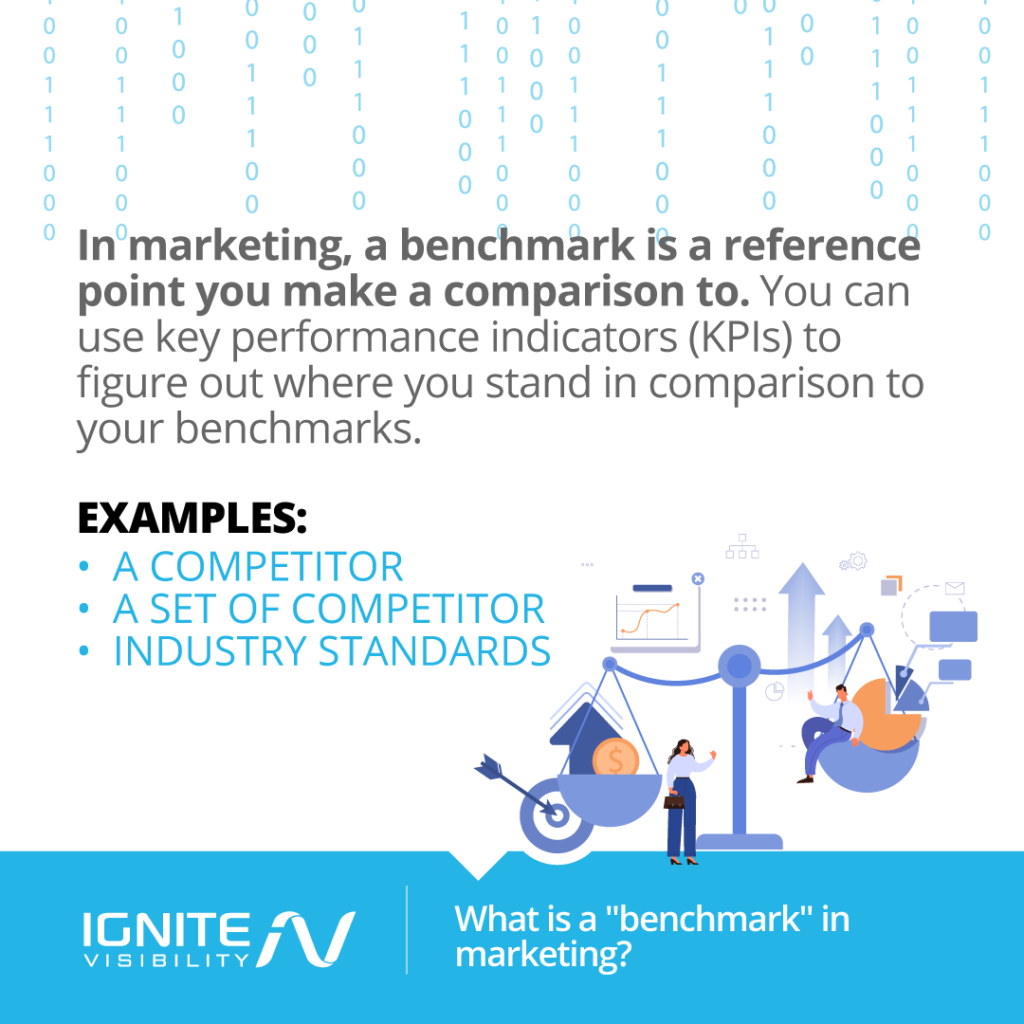
Definition of Benchmark Marketing
Different Kinds of Benchmark Marketing
We’re focusing on competitive and industry benchmarking here, but those aren’t the only kinds of benchmark marketing. Let’s look at the different types and how they can play into your digital marketing.
- Industry benchmarking: In this case, industry averages and best practices serve as the benchmark that you measure your own against. You can use both financial and non-financial indicators here, but you may have to dig a bit deeper for qualitative operational data.
- Competitive benchmarking: Here, you use your competition as a benchmark for your performance. Different KPIs can come into play here (for example, ad spend).
The following three types are a subsector of either competitive benchmarking or industry benchmarking, depending on the type of benchmark you use:
- Process benchmarking: Focusing on your company’s processes, you compare your efficiency and performance using internal or external benchmarks. These processes may relate to how you function internally or how you function with your clients/audience.
- Strategic benchmarking: This one focuses on your strategies, which involve business models and planning. It helps you prioritize the right things for optimum growth. You’ll be able to answer questions like, “What strategies do successful companies in my industry operate on, and how can I employ them to be more successful?”
- Performance benchmarking: This type uses performance-based KPIs to help you determine which outcomes you can improve upon. You can use quantitative indicators (like your rate of subscription renewals) or qualitative indicators (like sentiment toward your customer service).
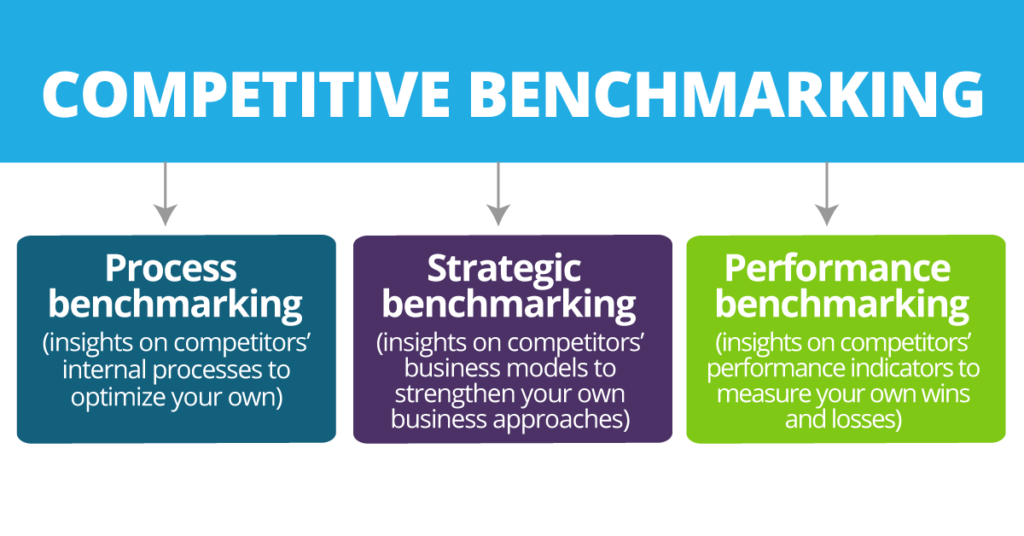
Subsectors of Competitive Benchmarking
Is a Gap Marketing Plan the Future of Marketing?
Benchmark marketing functions as a way to fill the gap between you and the competition. It really is the future of marketing.
For business-to-business (B2B) companies, in particular, making a marketing plan based on the gaps between you and others in your industry can help you soar to new heights.
How to Conduct Benchmark Marketing through Competitor Comparison
For competitive and industry benchmarking, there are certain steps you can take to complete your gap competitor analysis and plan. After these four steps, we’ll cover how to use your findings to scale your digital marketing efforts with a more profitable approach.
1. Consider These KPIs
Let’s get one thing straight: There are thousands of KPIs to choose from. The right selection of benchmarks depends entirely on your short- and long-term business goals. Plus, you need to consider the type of business you run and how your industry operates.
But certain KPIs are almost universally relevant. I’m going to lay out some of the top ones you should consider as you build your benchmark marketing plan.
All of the below examples fall under one of five categories:
- Growth
- Search engine ranking
- Social media presence
- Brand awareness and sentiment
- Product or service popularity
For example, you might choose:
- Number of active social media platforms
- Number of social media posts per week per platform
- Cost per lead (define your parameters for what constitutes a lead)
- Dwell time for a particular type of content (i.e. videos or blog posts)?
- Average click-through rate
- Rate of social media influencer engagement
- Number of Google My Business reviews
- Top visited/most popular pages
- Number of ranking keywords
- Rate of site traffic growth
Don’t overwhelm yourself with too many KPIs. You can always run supplemental audits for separate goals. Focus on one goal and choose 3–5 KPIs to support it.
By presenting these KPIs to your team, you can create a source of data to take real action on.
2. How to Conduct a Competitor Analysis
First, you need to choose who you’re going to label as a “competitor” in this particular gap marketing plan. It can either be an entire section of your industry or a handful of specific businesses. Choose from:
- Your closest competitors (for brick-and-mortar businesses, you’ll want to look local)
- Top businesses in your industry
- Top businesses shaking up your industry (i.e. the startups or companies disrupting the status quo to make something better)
- Industry averages or standards
You can use certain tools to help you with benchmarking (we’ll cover more about that in the next section). Once you have a lineup of competitors, you can move on.
Gathering data from your competition can be difficult. Use third-party tools to help you analyze their traffic data and growth potential. Finding financial information may prove more difficult, but you can search for industry studies to help you with this (the more insightful studies tend to be gated with email signup required).
Assign a particular person or team to handle the data. You want the same people tuned into the competition to get a more accurate feel for it. That way, they can present their holistic findings simply to the whole marketing department.
RELATED: How to Do an SEO Competitor Analysis: The Definitive Guide
3. Tools to Help You with Benchmarking
Using tools helps you to see where your competitors stand by giving you access to different KPIs. Here are some tools and how they can inform you:
- Google Analytics: Use the benchmarking report to analyze channel data, location data, and device data. Benchmark options include industry vertical, size by daily visits, and geographical location.
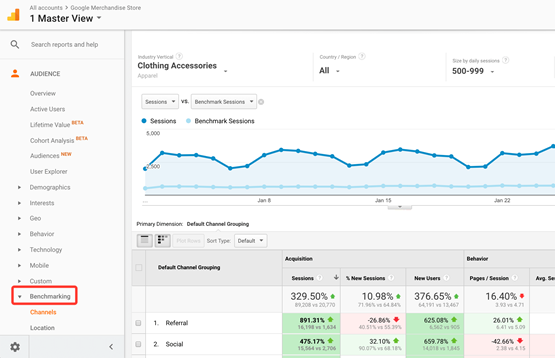
Google Analytics Benchmarking Report
- Similarweb: This paid benchmarking tool is a huge success. You can review industry benchmarks, compare your digital performance, reveal traffic sources, map the top players and home in on-site segments.
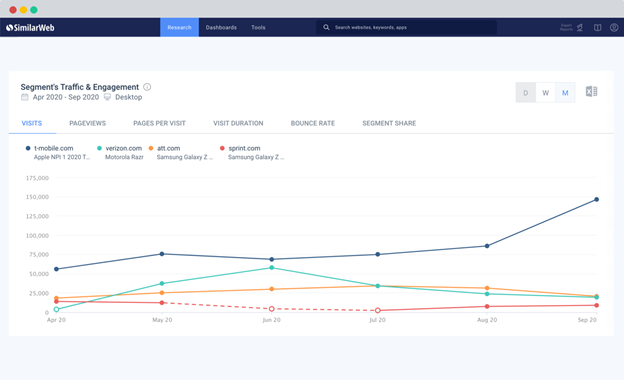
Benchmarking Report: Similarweb
- SEMRush: The paid competitor benchmarking toolkit in SEMRush lets you focus on traffic data, keyword gaps, backlink gaps, topic research, social media tracking, display advertising and more. It’s a really well-rounded tool that can help you achieve your goals.
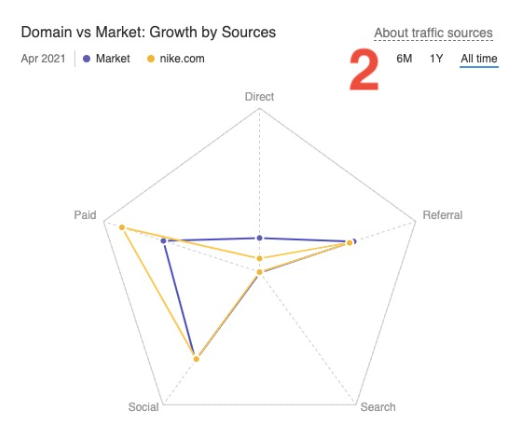
Growth Benchmarking Tool: SEMRush
- Pathmatics: Use Pathmatics to keep track of spending, segmented site competitiveness, and more. This paid option is good if you also want to take advantage of ad intelligence software.
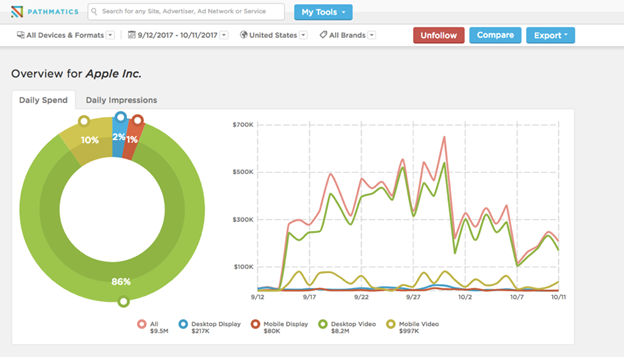
Benchmarking Report: Pathmatics
- Spyfu: The paid competitive keyword research tools from Spyfu help you build a keyword-focused gap marketing plan.
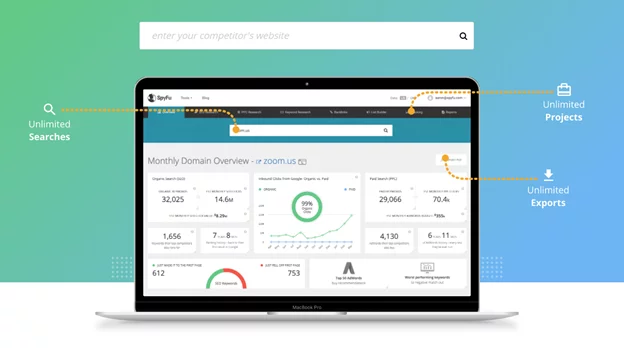
Keyword Gap Competitor Analysis Tool: Spyfu
- MailChimp: MailChimp has a campaign benchmarking feature to pit you against industry standards. This is specifically for email performance, so it’s great if email is one of your strategic marketing channels.
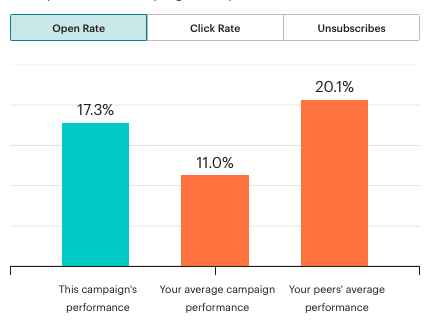
Email Campaign Benchmarking Feature: Mailchimp
- Twitter Analytics: Use Twitter Analytics to find your monthly statistics on tweet performance and audience insights. Compare it to industry standards or competitor results.
4. Look for Gaps and Fill Them In
Looking for gaps in your digital marketing footprint might mean finding gaps in your keywords, your social media reach, or your processes and performance.
By using the tools mentioned above, you can analyze data and find where your business falls short of the competition.
Those gaps are what you need to target, and your specialized digital marketing strategy is what you’ll use to target them.
Benchmarking is the primary way to identify where your gaps lie. Be like a scientist here by allowing your evidence to support your ideas, not the other way around.
RELATED: SEO Content Gap Analysis: Complete How-To
5. Weigh Your Spending Against Your Competition
How much are you spending and, in turn, making on that advertising investment? And how much is your competition getting back? This financial data can be tricky to score, but it’s super important if you want to know how your budget health stacks up in the marketplace.
Of course, you also want to focus on performance and the results of those spendings. However, the only way for you to know the rate at which you can scale is by finding out how much others are spending to get those results.
Without the monetary benchmark, you’re missing a crucial piece of the puzzle.
RELATED: 37 Competitive Analysis Tools That Will Improve Your Digital Marketing
How to Use Benchmark Marketing to Scale Your Digital Footprint
By continuing to focus on the benchmark marketing process, you can scale your digital marketing beyond your own expectations.
The whole point of benchmarking is to apply what you learn and act on it by adjusting your digital strategy. Approach your strategy every quarter (at least) to make sure your tactics line up with the KPI results you’re trying to achieve.
The newer you are at benchmarking, the more frequently you may want to adjust your digital strategy. However, it’s important to give each campaign a few months to get valuable pieces of data out of them.
Watch a Video on How to Scale Your Business Online
FAQs On Benchmarking:
1. What is a benchmark in marketing?
In marketing, a benchmark is a reference point that allows you to make a comparison. For your sake, you will likely use a competitor, set of competitors, or industry standards as a benchmark. You can use key performance indicators (KPIs) to figure out where you stand in comparison to these benchmarks.
2. How can you make sure your benchmarks are accurate?
Sometimes, industry averages don’t accurately reflect your personal competitive landscape. Maybe you’re in a niche field or the local competition is more reminiscent of what you’re looking for. Whatever the case, you may need to hone in on specific competitors to avoid reaching for inaccurate goals (whether they be too high or too low).
3. What are some examples of benchmarking in action?
MailChimp released an industry study for email marketing, with data separated by industry.
You may also look at Google Analytics to get website traffic competitive benchmarks.
4. What tools help with benchmark marketing?
Google Analytics, Similarweb, SEMrush, Pathmatics, Spyfu, and MailChimp are just a few analytics tools you can use to help get benchmarking data. They each have their own specialties.
Wrapping Up Benchmark Marketing
Gathering data and setting a benchmark can help you reach your goals.
It’s a way to create something actionable and tangible. Build and pivot your marketing strategies in accordance with your competitors and industry findings.
Need help getting started? Get in touch!